
Upgrade to High-Speed Internet for only ₱1499/month!
Enjoy up to 100 Mbps fiber broadband, perfect for browsing, streaming, and gaming.
Visit Suniway.ph to learn
MANILA, Philippines — A resounding standing ovation erupted after artists, colleagues and fans bid farewell to National Artist Nora Aunor during a necrological service held in her honor at the Metropolitan Theater.
The “one and only superstar” was given a hero’s sendoff for her life’s work that gave a voice to the voiceless, championed the marginalized in society and embodied the soul of Philippine cinema.
Among those who delivered moving tributes were National Artist for Film and Broadcast Arts Ricky Lee, acclaimed filmmaker Joel Lamangan, and former ABS-CBN executive and actress-producer Charo Santos-Concio. Their words painted a portrait of Nora not just as a star, but as a cultural force, a rebel, a giver — and ultimately, an artist of the people.
Award-winning screenwriter Ricky Lee, who collaborated with Aunor in some of her most unforgettable roles, including “Himala” and “Andrea: Paano Ba ang Maging Isang Ina?” recalled how Nora resonated deeply with ordinary Filipinos.

Speaking on behalf of the family, Ian expresses their gratitude to colleagues, peers, supporters and Noranians.
“Noong 1993 ay naglibot sa iba’t ibang bansa ang dulang DH na sinulat ko at pinagbidahan ni Guy,” Ricky began. “Nagpunta kami sa Central Park sa Hong Kong. Daan-daang DH (domestic helpers) ang nandoon. Halos bawat isa ay niyayakap ni Guy, kinakausap, kinukumusta kung ano ang mga problema nila.”
As they were leaving, Ricky said that he witnessed something unforgettable. “Lumingon ako at nakita kong tumatakbo sa kalsada ang mahigit sampung DH, lumuluha habang humahabol sa van.
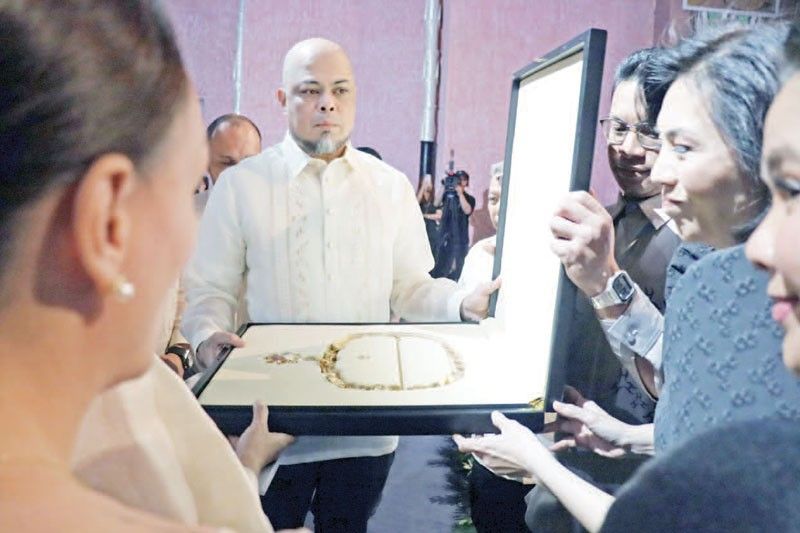
The National Artist medallion is entrusted to the children of Nora — Lotlot, Ian, Matet, Kenneth and Kiko.
“Pinagmasdan ko si Guy at naisip ko, bakit ganito ang epekto niya sa tao? Bakit sila umiiyak?” The answer, nevertheless, was clear — they saw themselves in Nora. “Dahil nakikita nila si Guy sa kanilang mga sarili. Dahil sila si Guy,” he said.
For him, it was this kind of connection — deep, authentic and even wordless — that defined Nora’s artistry. He particularly cited how in “Himala” (1982), despite many of the 3,000 extras not understanding at that time her monologue in the Ishmael Bernal film, they were moved by her delivery.
“Nasa puso ni Guy ang masa. May paraan siya ng pagkonekta sa kanila na hindi laging nangangailangan ng mga salita,” he said.
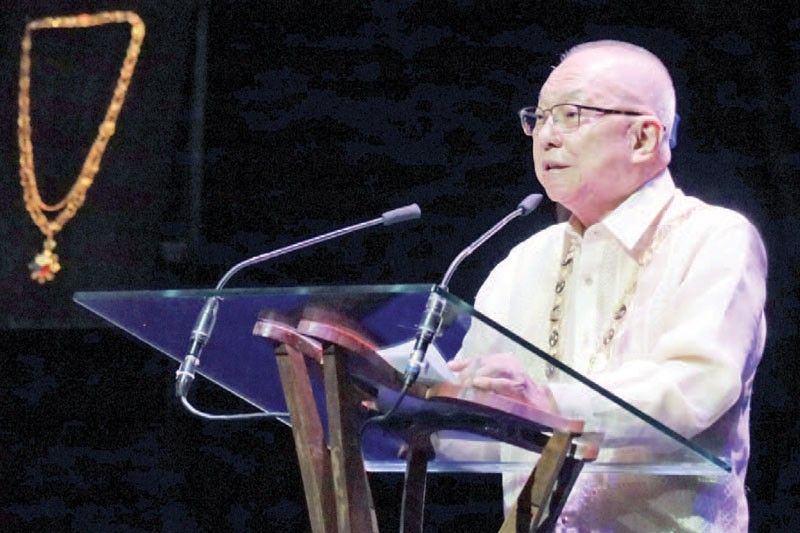
National Artist Ricky Lee.
For Ricky, Nora was not just an actress; she was a rebel who defied industry norms and redefined what beauty, strength and artistry looked like on screen.
“Sa loob ng pitong dekada ay nilabanan niya ang status quo,” he said. “Binago niya ang kolonyal na pagtinging nagsasabing mga mapuputi lang at matatangkad ang maganda sa puting tabing.”
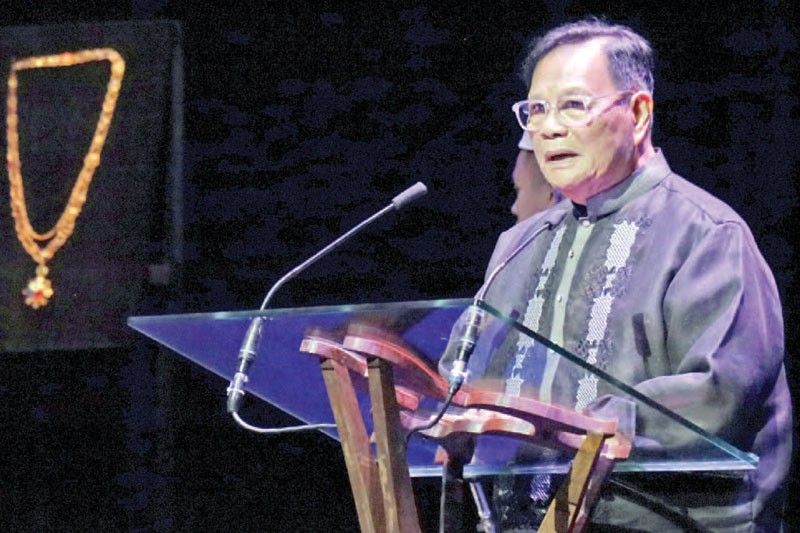
He pointed out her astounding range of roles — from nun, prisoner, lesbian, NPA, OFW, mistress, servant, villain, Muslim, Igorot, to assassin and one suffering from dementia.
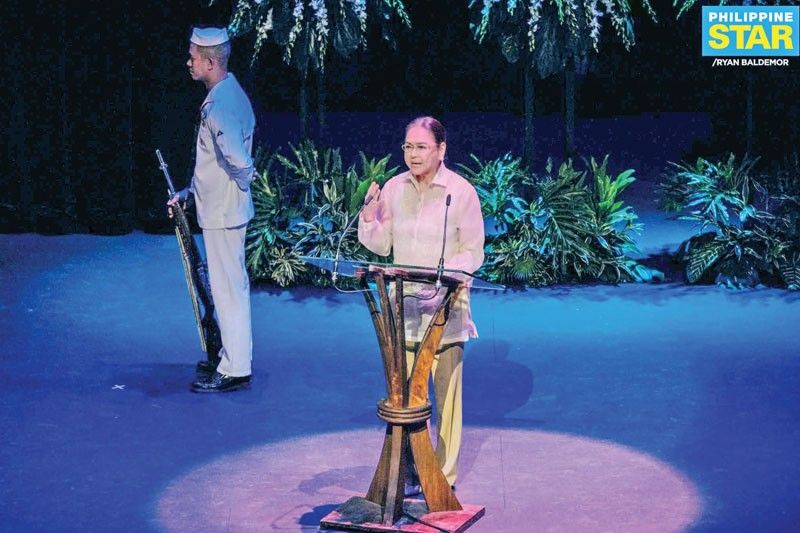
Actress-producer Charo Santos-Concio.
Even in eras when the idea of a lead character dying in a film was taboo, she dared to challenge that norm. “Sa isang panahong hindi tanggap ng mga tao na namamatay ang bida sa ending, namatay siya sa ‘Tatlong Taong Walang Diyos,’ ‘Himala,’ ‘Nakaw na Pag-ibig,’ ‘Andrea,’ ‘Flor Contemplacion,’” Ricky said.
According to him, she chose not just to be a superstar, but to be “isang tunay na artista ng bayan.”
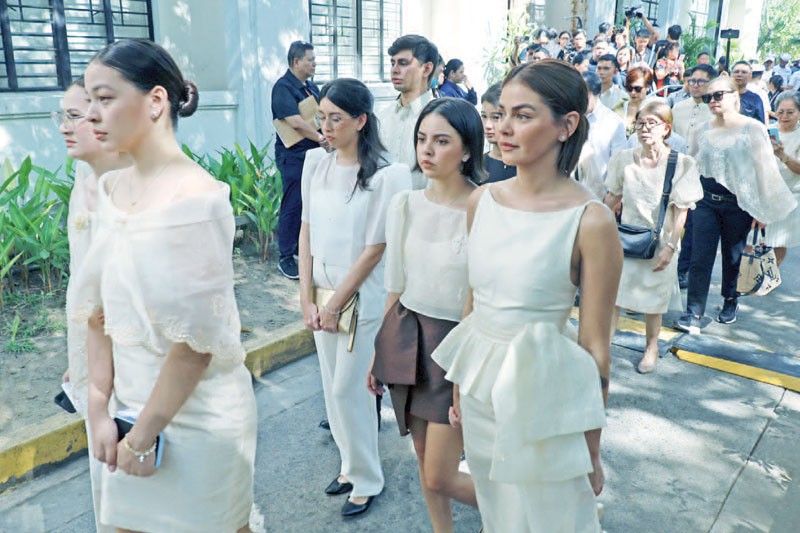
Nora's grandchildren, including actress Janine Gutierrez, at the Metropolitan Theater before the service.
Ricky also spoke of the high cost of stardom and the contradictions that came with Nora’s life. “Simple pero komplikado. Laging nakangiti pero sa loob ay maraming takot. Sobrang mahiyain pero sentro ng atensyon.” But despite her stature, she was very accessible. “Napakadaling maabot. Isang taong ordinaryo, na ekstraordinaryo.”

Jed Madela and Angeline Quinto perform the Nora Aunor song, Superstar ng Buhay Ko. — Photo courtesy of CCP
He recalled a moment of vulnerability when he asked her why her eyes always seemed filled with sadness. “Sinabi niyang ipinaglihi daw kasi siya ng ina niya sa Mater Dolorosa — iyong may pitong punyal sa puso,” he said. “Kaya siguro kahit na nakatawa siya, sa mga mata niya ay may lungkot pa rin.”
And while she gave everything to her audience — her voice, her time, her love — he said that she was often left with very little. According to Ricky, even in her final years, she dreamed of building a foundation to help her fans.
“Kaya sa gitna ng ating pagdadalamhati ngayon,” Ricky continued, “gusto nating sabihin sa kanya, Guy… tanggapin mo ang aming walang hanggang pasasalamat. Nagpapasalamat kami na nabuhay kami sa isang panahong naririto ka.”
Director Joel Lamangan also shared anecdotes from working with Nora, but turned emotional as he lamented the words he never got to say while Nora was alive. “Hindi ko man lang nasabi kay Ate Guy nung buhay siya na isa siya sa pinakaimportanteng tao para sa akin,” he said, “dahil sa kanya nabuo ang paniniwala ko na ang pulitika ay dapat talagang sumasanib… sa ordinaryong tao.”
He recalled a conversation with her during a difficult time in the country. When he asked where she stood, she responded: “Kung saan lalago, kung saan makikinabang ang ordinaryong tao, doon ako.”
He described how Nora’s acting was rooted in truth, how her emotional depth exposed realities that others sought to ignore. “‘Ang katotohanan ay hindi dapat pagtakpan, ang katotohanan ay dapat sabihin,’ yan ang sinasabi ni Nora Aunor, lalo na sa pulitika ng ating bayan.”
And even when others in the industry turned their backs on her and didn’t see the box-office value of casting her, direk Joel said that she remained steadfast. “Sabi ko, ‘Ate Guy, hayaan mo sila. Gagawa tayo.’ At gumagawa siya. Gumagawa siya ng indie at tinutulungan niya ang mga independent films.”
Joel hailed her as a true symbol of Philippine cinema, with her life and legacy serving as a reminder that cinema is not a trivial art — it is a powerful and meaningful medium. “Mahal ni Nora Aunor ang pelikula. Kailangang mahalin din natin ang pelikula dahil… ito ay artistic expression ng bayan.”
Producer and actress Charo Santos, who worked with Nora in “Himala,” among others, and became one of her close friends, echoed the sentiments of those present.
“Walang himala. Pero mayroong nag-iisang Nora Aunor,” she said.
Charo reflected on how Nora’s real-life journey — from selling water and peanuts near the train tracks to becoming a National Artist — mirrored the very characters she portrayed: Elsa, Corazon, Delia, Flor Contemplacion. But even those roles couldn’t capture the magnitude of who Nora Aunor was.
“She was even bigger than all her roles,” Charo said. “Binibigyan niya ng buhay ang pangarap ng milyun-milyong Pilipino.”
Her legacy, according to Charo as a die-hard fan, isn’t just found in awards and iconic performances, but in the way she made fans feel seen, heard and represented. “We were called the bakya crowd, and we were proud of it, dahil may superstar kami, na isa sa amin.”
Charo also recounted the first time she worked with Nora — on “Himala,” where Charo served as producer. It was then that she witnessed firsthand the power and artistry of Nora’s performance.
“There’s something about her that cannot be explained by technique alone,” she continued. “She is raw. She is real. She is authentic. She doesn’t act. She becomes. She transforms.”
Even amid fame and adulation, Charo said that Nora remained the same simple probinsyana at heart. “Walang attachment sa glamour, fame or wealth,” said Charo.
“Ang naging mahalaga sa kanya ay ang kanyang dedikasyon sa kanyang craft dahil yun ang kanyang sukli sa pagmamahal ng kanyang mga tagahanga.”
After the necrological service, the remains of Nora who passed away on April 16 at the age of 71, were brought to the Libingan ng mga Bayani in Taguig City, where she was laid to rest with full military honors.

 1 month ago
11
1 month ago
11


